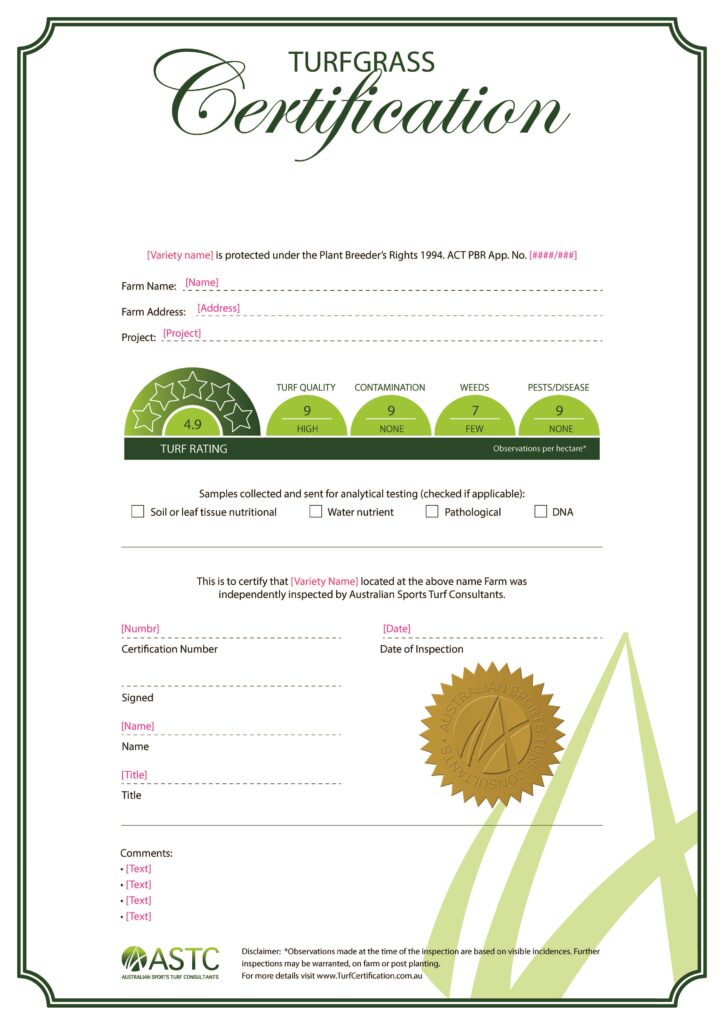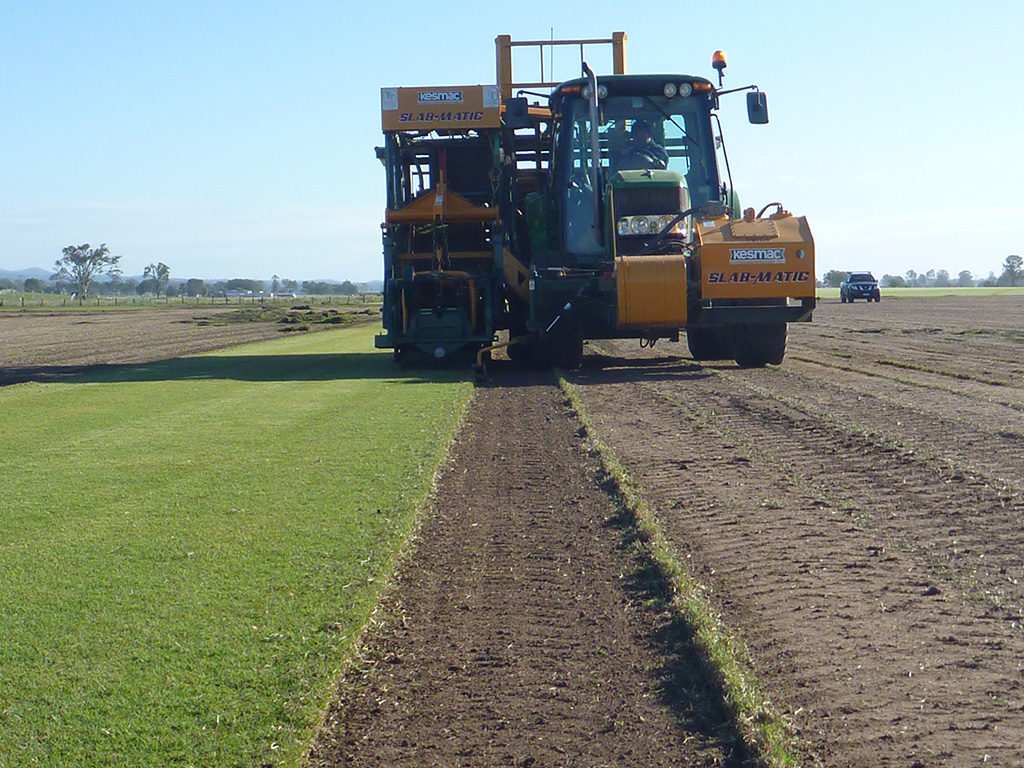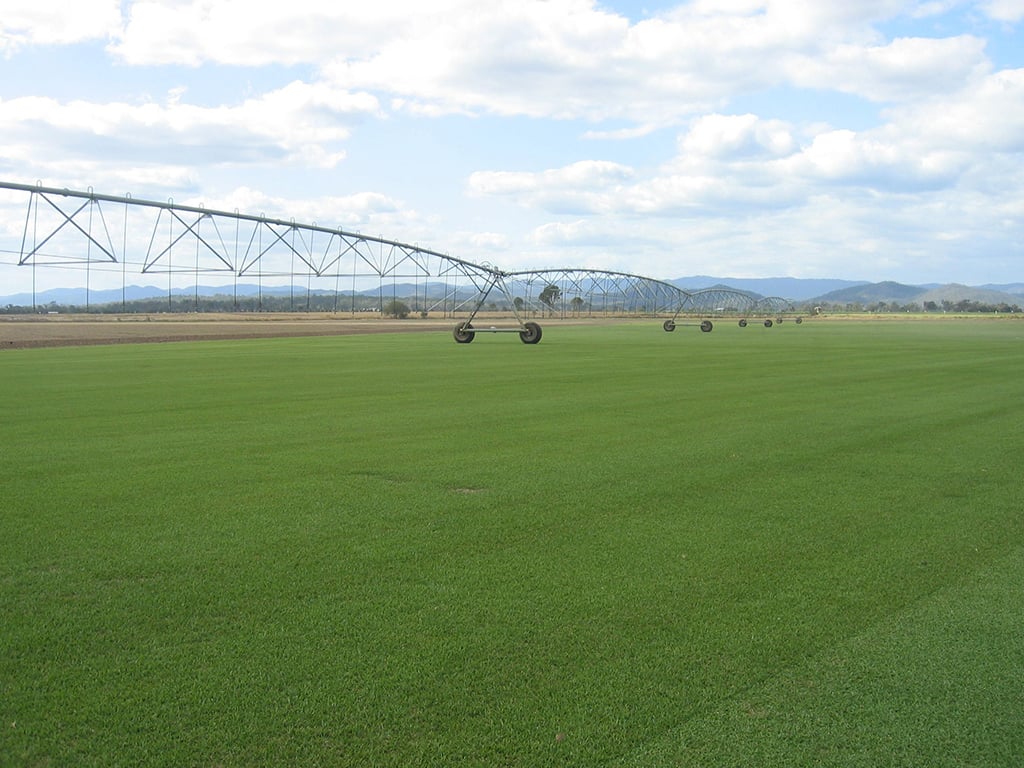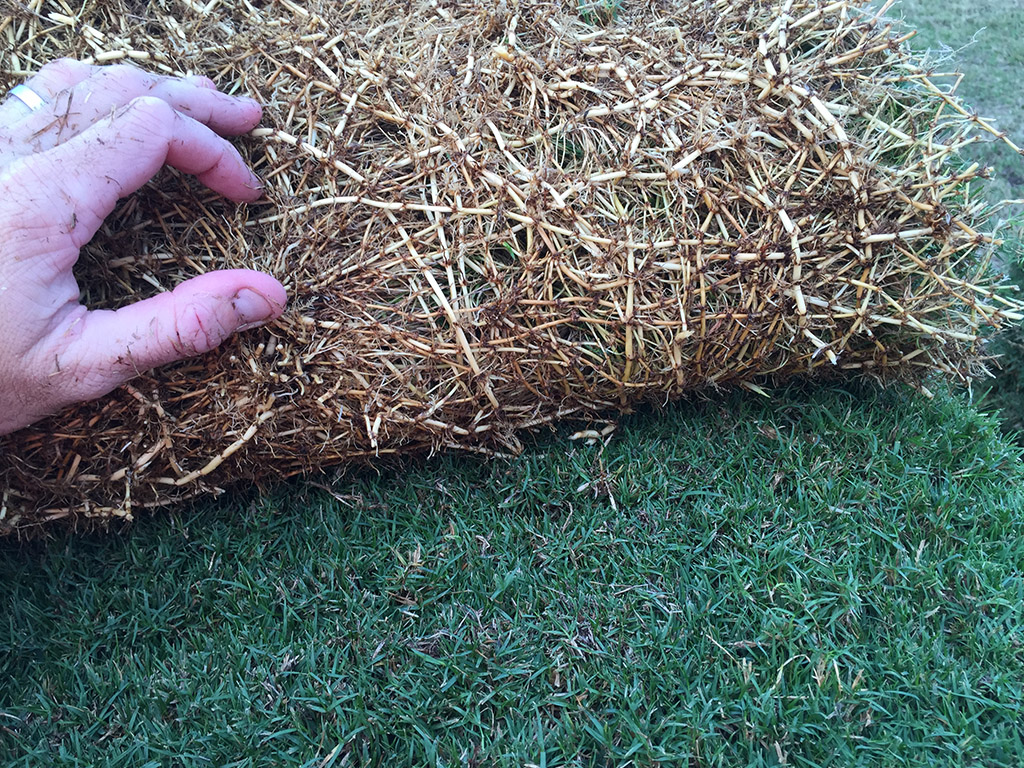Turf Certification
Turf Inspections
ASTC conducts independent turf farm inspections for quality control (breeder) purposes, turfgrass certification, sports field and commercial installations for clients. This includes routine inspections, turf certification, turf suitability and pre-harvest inspections.
During inspections ASTC looks to assess:
- That the turfgrass, where applicable, is true-to-type
- Turf uniformity
- Turf quality, colour and health
- If contamination can be seen
- Incidence of pests, diseases and weeds.
ASTC can also collect sampling for analytical testing, including DNA, soil nutritional, soil physical testing, leaf nutritional, water nutritional testing and pest and disease identification etc.
Turf Certification
An example of a certificate is provided below. A turf certification certificate can be provided following an independent farm inspection. Documentation of this nature is often requested for Quality Assurance purposes.

Turfgrass Rating
The Turfgrass Certification “Turf Rating” (0.6 to 5 stars) is based on the following information and criteria:
- Turf Quality: Rating of 1 to 9, with 1 being poor or dead, 6 being acceptable and 9 being perfect or ideal. The weighting Turf Quality has on the Turf Rating is 55%.
- Contamination: Rating of 1 to 9, with 1 being high, 5 being moderate, 7 being few and 9 being none. The weighting Contamination has on the Turf Rating is 25%.
- Weeds: Rating of 1 to 9, with 1 being high, 5 being moderate, 7 being few and 9 being none. The weighting Weeds has on the Turf Rating is 10%.
- Pests and/or Disease: Rating of 1 to 9, with 1 being high, 5 being moderate, 7 being few and 9 being none. The weighting Pests/Disease has on the Turf Rating is 10%.
Supplementary comments are also provided on notable observations made during any inspection. Recommendations may also be listed, if applicable, for the turfgrass to be deemed suitable to meet specification or be fit-for-purpose.
Warm-Season Grass Experts
ASTC staff are specialists in the identification and management of the following warm-season turfgrass species:
- Cynodon hybrid and green couch (Cynodon spp.)
- Buffalo grass (Stenotaphrum secundatum)
- Blue couch (Digitaria didactyla)
- Zoysia grass (Zoysia spp.)
- Kikuyu (Pennisetum clandestinum)
- Paspalum (Paspalum spp.)
- Marine couch (Sporobolus virginicus)
Inspections Completed
ASTC has completed numerous inspections for organisations, including:
- Numerous council's for sports field construction and redevelopment projects
- 2018 Commonwealth Games – Carrara Sports Precinct (training field and main arena)
- Eagle Farm Racecourse redevelopment
- Townsville Racecourse redevelopment
- AusGAP
- Lawn Solutions Australia (LSA)
- HG Sports Turf
- Hancey’s Turf
- New Frontier Brands Pty Ltd the Licensors of New Frontier (TBLL) buffalograss.
- Oz Tuff Pty Ltd the Licensor of OZ TUFF green couch.
- Cervadon Ltd the owner of AgriDark (AGRD) hybrid green couch.
- Grand Prix green couch being grown at Tinamba Turf and previously at Turf Force.
- Ozbreed Pty Ltd the (former) owners of Zoysia varieties Empire and Nara, and buffalograsses Palmetto and Sapphire.
- Growers of Wintergreen green couch.
Contamination in Turfgrass
In recent years numerous discussions have taken place between turf farm owners, breeders, consumers and/or IP Australia (who administrate Australia’s intellectual property (IP) rights system, including Plant Breeder’s Rights (PBR)) regarding turfgrass contamination. ASTC Director Matt Roche asked the [now former] Chief of Plant Breeder’s Rights Mr Doug Waterhouse the following question regarding quality control and contamination within PBR protected turf varieties.
Question. “If contamination is found within a PBR turf variety growing on farm, is this considered unacceptable and can the turf farm or breeder be in breach of the PBR Act [Plant Breeder’s Rights Act 1994]?”
Answer. “There are many elements to this question, not all of which are PBR; for example, the Competition and Consumer Act 2010 (formerly known as the Trade Practices Act 1974) adequately deals with mendacious variety declarations. Thus if a grantee sells turf as one variety when it is actually another, recourse is through normal competition law. Accordingly both seller and buyer should establish the purity of the material on offer.
In addition, PBR accepts that varieties have some “contamination” usually by way of “off types”. This is the “uniformity” standard of which you are aware. There is also the “stability” standard, though for asexually reproduced varieties, this is of lesser importance.
In relation to uniformity, there comes a time when the material is so un-uniform that it no longer complies with the variety’s description – and therefore is arguably not the variety anymore. Obviously this does not apply to (deliberate) admixtures which fall within competition law as outlined above. Grantees are responsible to ensure that their varieties remain true to their description when grown in the relevant environment” (D Waterhouse 2013, pers. comm., 12 September).
Of significant note is Mr Waterhouse’s comment in relation to “Accordingly both seller and buyer should establish the purity of the material on offer.” This should be in the form of independent turfgrass inspections and turf certification.








